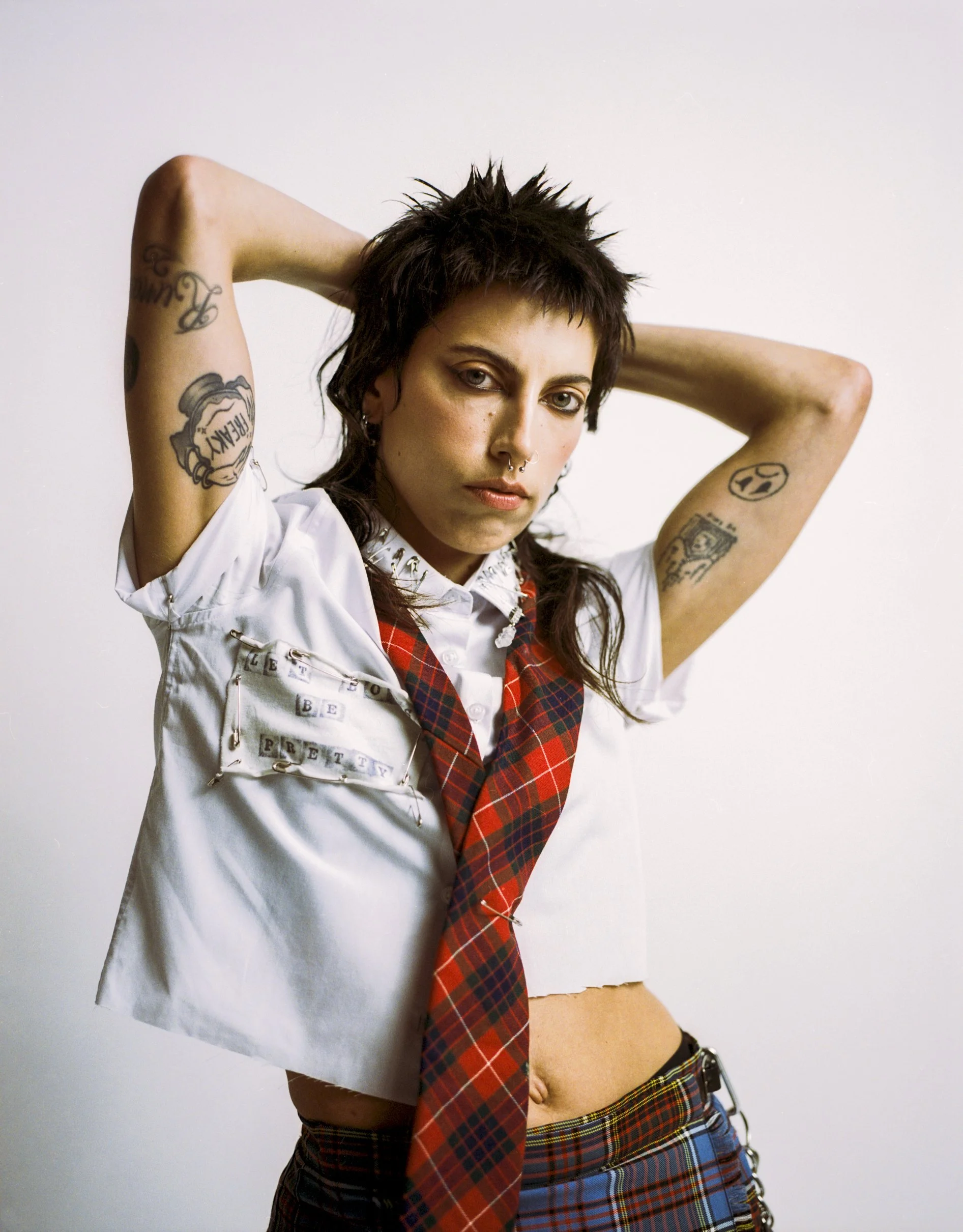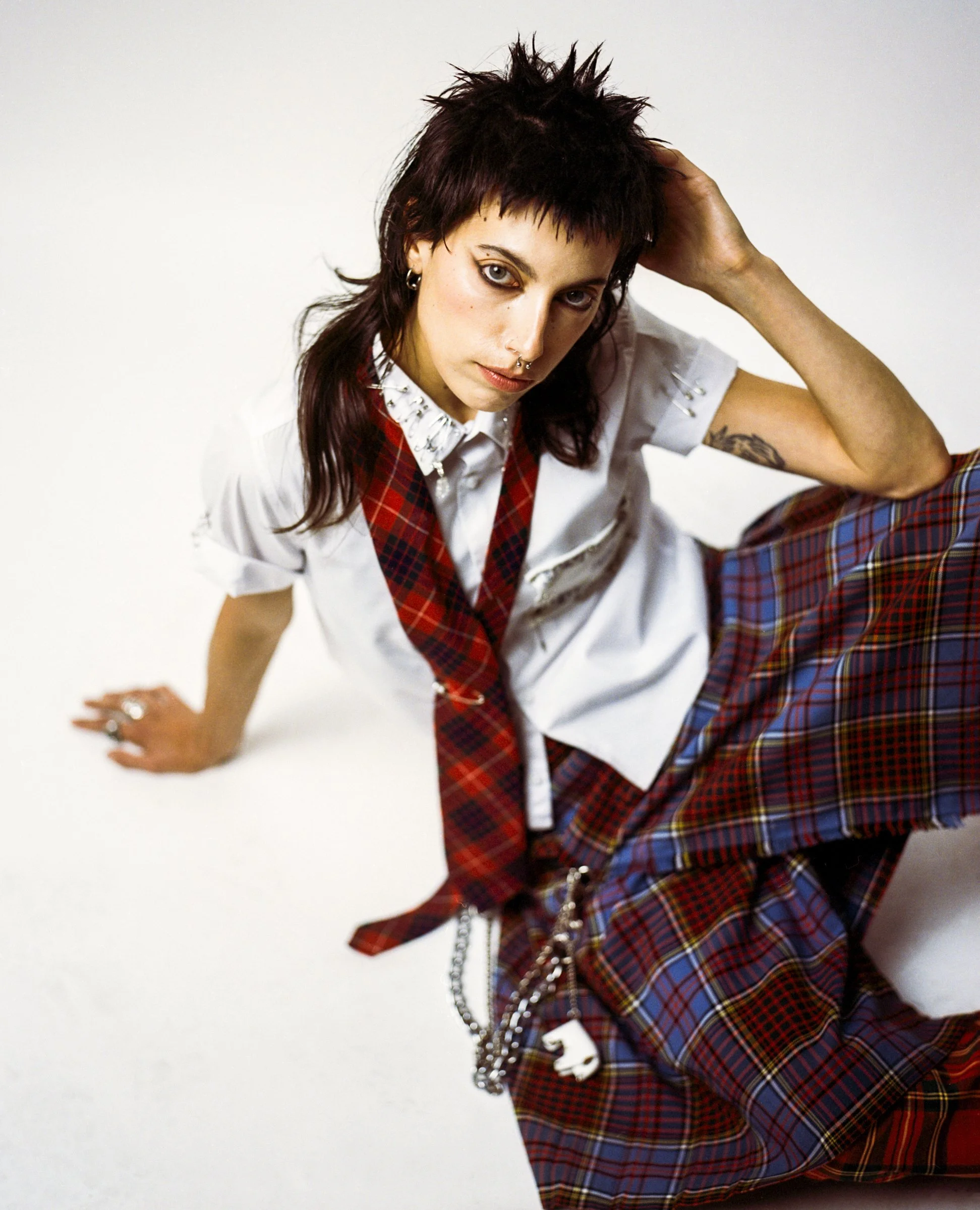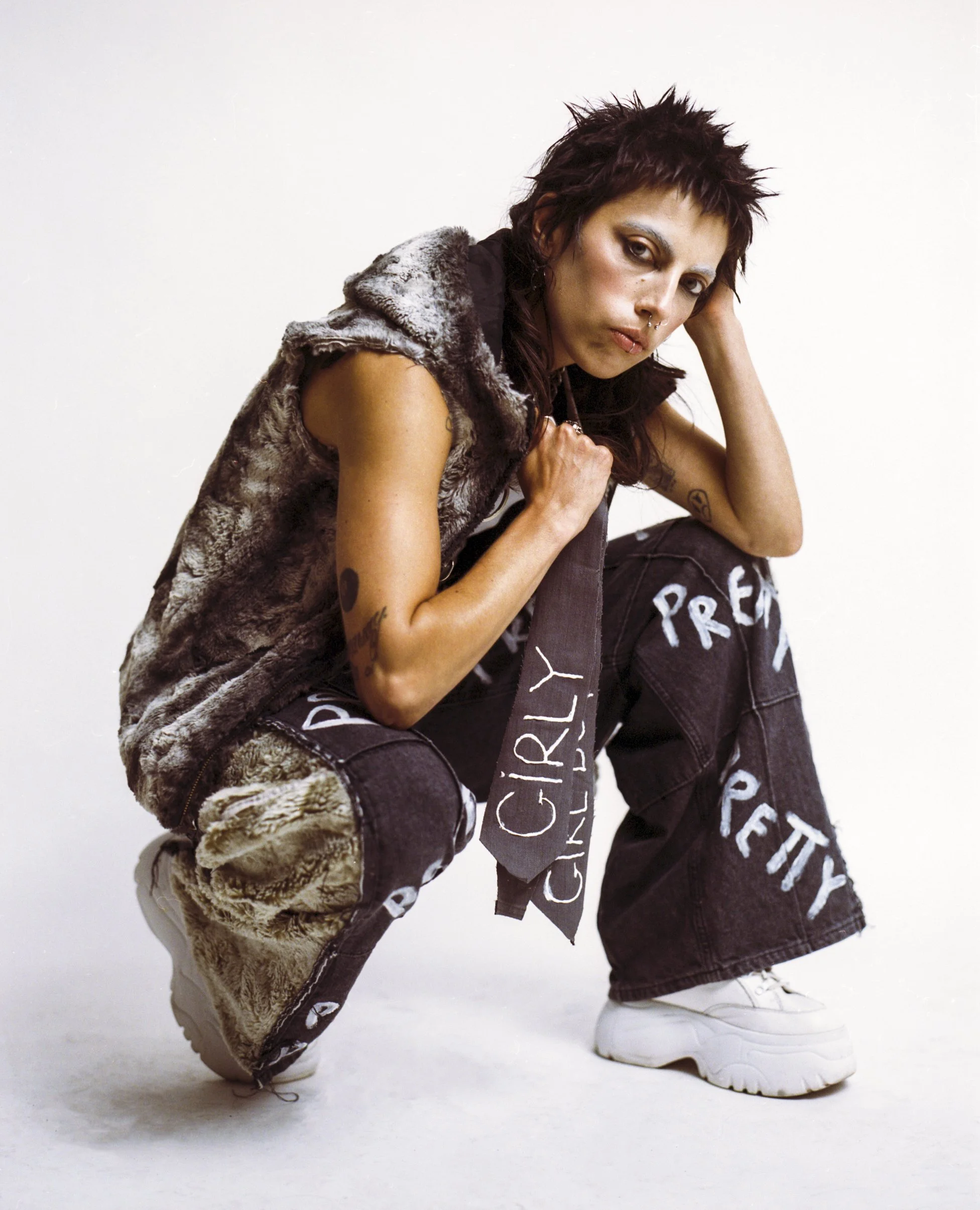In Style with Santi
This month we met up with the ever-so-stylish Santi Sorrenti to explore all things upcycled, DIY and gender-nonconforming fashion. Founder of the organisation G(end)er Swap, Santi discusses their work creating accessible style resources and outreach for the LGBTQ+ community. As a self-proclaimed ‘DIY fashionista’, Santi upcycles clothes as a means of connecting with his community and exploring his own identity. Self-styled in their own creations, their personal style and DIY techniques are showcased in our editorial. Santi dons layered materials and poignant graphics, all embellished with chains, pins and studs. Shot by the incredible Kairo Urovi, with stunning smokey eyes from make-up artist Eden Clark and striking spikes from Hair Stylist River Perry, we are overjoyed to introduce to you - In Style with Santi.
“Throughout my entire life, I have used clothes to convey a message and to purposely ‘look different’ from the rest”.
Dyke Digital: What was the first piece of clothing you ever DIY-d? What effect did this have on you?
Santi Sorrenti: I have DIY-d so much that it’s going to be difficult to trace my very first item. The creation that sticks out for me is a black T-shirt which I painted a bright orange sad face onto in 2017 when I was at uni - a reflection of the misery I was feeling as a perfectionist getting my dissertation done. Also, a burgundy jumper that I upcycled with a PVC kangaroo pouch and gold studs several years before my studies when I was living in Berlin and selling my clothes at flea markets to get by. Then there was the white denim Topman vest that I turned into an IKEA-inspired piece during the pandemic which resonates with me the most. I upcycled it during the first lockdown in 2020 on an Instagram Live to inspire people to start their own style projects and keep busy. I cut up a blue IKEA bag and used the blue and yellow logo straps to create stripey borders along the front pockets and glued some along the back to create dangly fringe, as well as painting some parts of the vest black. At Trans Pride, I wore my banner on the back of the IKEA vest (painted words on a piece of black fabric and safety pinned to the blue plastic) which said “TRANS PEOPLE ARE THE BEST DRESSED”. This piece in particular made me feel really euphoric because of it’s big wide shoulders and oversized fit - and because every time I wear it out people ask me where I bought it. I feel a sense of freedom in knowing that I am the only one wearing the piece and that I can inspire people to create their own one-of-a-kind items by sharing my process with them.
DD: How has constructing your own pieces played a role in your style and personal development?
SS: Constructing my own pieces has led to an immense sense of freedom for me. I often get flooded with ideas for things that I want to wear or ways in which I want to express myself and I usually can look at an item in a charity shop, or pull something from my wardrobe, and have the immediate vision to turn it into a wearable piece of art that feels like ‘me’. The whole process is a therapy session for me. Throughout my entire life, I have used clothes to convey a message and to purposely ‘look different’ from the rest. In elementary school, I commissioned my mom to make me a coordinating two-piece: a pair of bell bottom flares in a bright colour with a matching jacket. I used to get bullied a lot for my off-key fashion when I was a kid and now I embrace it. I actually still am very obsessed with making myself two pieces but now I make them myself t channel my feelings or personal experiences. Constructing my own pieces has been important for starting conversations about gender or gender non-conforming expression more widely and on a practical level I have built on my upcycling techniques through experimentation and taking risks. Without this outlet, I don’t know where I would be - or how I would get dressed. I love wearing things that I make.
DD: Do you have a favourite DIY item? One you are most proud of or attached to?
SS: My favourite DIY item to date is my two-piece astrology outfit. A pair of long black shorts (which were Zara trousers I found on the street) that I upcycled with words, each letter I cut out from a pair of charity shop jeans. I then thrifted a black jacket and added fake Burberry print to the collar and pockets. I also cut up an astrology T-shirt an ex gave me and sewed it on the back. I finished off the piece by covering it with safety pins and leaving all of the sewing threads loose (one of my signature touches). I attached a patch on the front that I bought in Portland, Oregon (also that I purchased on a trip with another ex) and attached it to the front - it says TOMBOY. I love this two-piece because it incorporates two topics that I love to obsess about: astrology and gender. On top of that, I must say there is something powerful about transforming clothes that your ex gave you. Deconstructing gifts to give them new life, new meaning and a new history.
“Everyone has a personal fashion sense that is deemed unique, valuable and meaningful outside of what the mainstream fashion world prescribes”.
DD: How do you feel DIY and Queer expression integrate?
SS: DIY and queer expression intersect so heavily. I like to rant about the resourcefulness of queer and trans people and their savviness in creating aesthetics and sharing resources that haven’t always been available to us. Where there is a lack, we have definitely swooped in to create something that works for us. Queer and Trans people have used (and continue to experiment with) DIY methods to create gender-affirming expressions - from DIY binding techniques to home haircuts, handmade patches and badges and accessories too. A lot of DIY stems from the underground worlds queer people have created to explore and play with expression. We always have used DIY to ‘make things work’ and to tailor things to our needs. Queer people are so incredibly creative and a lot of the DIY work we have resorted to has been an act of resistance against heteronormative expectations - especially around dress.
DD: Are you planning to sell your pieces? If so, how?
SS: Yes! I have created and sold a lot of DIY garms to queer people, and lot’s of drag artists, under the brand Pretty Boy Spice. I am now re-branding under the name GIRLY BOY and you can find pieces for sale in the highlights section of my Instagram (with a website) coming soon.
DD: How would you describe your personal style? You have previously described yourself as a ‘DIY Fashionista’, what does this mean to you?
SS: Some of the terms that I use to describe my personal style are gender weird, pretty boy, girly and kitsch. I love integrating Y2K nostalgia and toys into my aesthetic too and I sometimes use the term kidcore or gendercore to describe my style. Calling myself a DIY fashionista stems from primarily using a lot of mismatched, quick and crafty methods to put together my look. A lot of my expression incorporates knick-knacks and toys from the thrift store as accessories, sewing together a garment with no official pattern or methodical process and glueing or safety pinning a lot of things together. Finding jammy ways to create an aesthetic is a huge part of my DIY approach and an important way for me to inspire more queer people to create a personalised expression that doesn’t require elaborate skills or money.
DD: Has performing in Drag affected or changed your style in any way?
SS: Performing in drag has really pushed my personal sense of style further into embracing my femininity or inner ‘femboy’. I wear more skirts than ever before! I have also incorporated new DIY methods into my clothes post-drag - I got really obsessed with puff paint and over-accessorising with carabiners this summer thanks to Pre-T Boy ( my drag persona) who has no limits to expressing their (trans) masculinity. Part of my re-brand to GIRLY BOY has been heavily inspired by my drag and embracing the term ‘girly’ or ‘girl like’ has been a product of exploring my inner gay boy in drag. Being a pretty boy, in my world, involves the incorporation of feminine qualities and I have taken this to the ninth degree with my new brand!
DD: What are your thoughts regarding the term ‘Anti-Fashion’?
SS: I love the term ‘anti-fashion’ and often use it. It really carves out a space for people to wear what they want and to free themselves from the expectations of what is trending at the moment. Anti-fashion has a deeper meaning for me and is a term I often allude to in my style outreach work with G(end)er Swap. It operates in a sustainable way: swapping or thrifting for clothes instead of going into a mainstream shop and buying them new. The term ‘anti-fashion’ also challenges the idea that only some things are deemed ‘fashionable’ and others not. Whether you are into clothes or not, everyone has a personal fashion sense that is deemed unique, valuable and meaningful outside of what the mainstream fashion world prescribes. In other words, ‘anti-fashion’ defies societal expectations of what one should dress like. Instead, I like to celebrate all forms of expression that are unique to every individual.
“I must say there is something powerful about transforming clothes that your ex gave you. Deconstructing gifts to give them new life, new meaning and a new history.
”
DD: How does your gender identity play in how you dress? How do you feel dress and style play a role in personal gender affirmation?
SS: My gender identity massively plays into what I wear. I am really big on transforming stereotypically feminine or childlike aesthetics to form a playful and ‘boyish’ expression. I use the terms Genderqueer and Pretty Boy to describe my gender and every time I get dressed I often think about ways to incorporate playful gender elements that feel affirming but also embrace the messy, confusing, vulnerable but also fun experiences of gender and gender expression. I like to revel in all of those feelings when getting dressed - and I want others to see it when they interact with me and my outfit.
Dress and style play a huge role in gender affirmation simply because we gravitate towards the clothes that make us feel good in our bodies and in the identity that we hold close to us. There’s a lot of discourse on whether clothes have gender and whether clothes dictate what someone’s gender is. I think this isn’t necessarily something we have to focus on. Rather, I like to say that all clothes are gender-full and you can imbue them with whatever meaning you want them to have. I also think clothes feel more affirming when you customise them with your own personal touch - whatever that may be. There is so much power in it and it feels the most affirming when you feel like you have agency over what you want to wear and how you want to wear it.
DD: On this note, When and why did you start G(end)er Swap?
SS: I started G(end)er Swap in 2017 as a queer community clothes swap. At that time, I was heavily questioning my gender identity and wanting to create a space where I could talk about it with others. When searching for queer-style events in London, I couldn’t find much except for one-off clothes swap events.
Historically, I have always thrifted, so I again turned to thrifting during my gender woes as a way to experiment with style. Combining the solace I found in accessing thrift stores and my negative experiences in mainstream shopping spaces (when I got kicked out of Topman and Zara man changerooms), I decided to create G(end)er Swap, a space for folks facing similar experiences. My initial idea was to do a monthly clothes swap where people could make friends, find new clothes and exchange DIY style tips. Since then, it has expanded into a massive style outreach organisation that serves gender-diverse people across the UK (and internationally) with style resources, style workshops, pop-ups and educational events on expression to support the Trans community.
The purpose behind G(end)er Swap is to create safe spaces where folks can BE WHOEVER and WEAR WHATEVER (our mission statement!) – where they can experiment with different forms of self-expression and access gender-affirming style info. With G(end)er Swap, I also provide consultancy to businesses and organisations to promote greater trans-inclusivity within mainstream and corporate environments, creating and fostering awareness of gender diversity through the lens of fashion.
DD: Why do you feel style outreach and free self-expression is important for the trans & queer community?
SS: Style outreach for the trans community is so essential because the mainstream fashion world doesn’t have a structure in place that supports trans and gender non-conforming people who are seeking a new form of expression. Mainstream brands and retailers don’t provide comfortable environments for gender-diverse folks. For example, clothing sections and changing rooms are often heavily gendered. The way that garments are designed is also not made for trans and GNC bodies, which can lead to a lot more distress and dysphoria.
When transitioning, finding an entirely new wardrobe can be very costly. For a lot of folks, buying a whole new wardrobe is not financially feasible. There are also not a lot of resources out there that support trans people with information on how to shop for clothes or where to begin when constructing a new personalised style from scratch. My approach to style is through a sustainable and DIY lens because it gives people a sense of agency and the self-confidence to build a gender-affirming style through very tangible and cost-effective means.
Organisations like G(end)er Swap are needed because there is no way in hell mainstream or high street brands are factoring in trans people into their designs and although we are seeing a lot more queer/trans-led brands out there - the prices often aren’t affordable. Lastly, a lot of mainstream fashion doesn’t really promote individuality or reflect what gender-diverse people need. With the style outreach work that I do, I create style resources in direct response to requests from the community, ensuring G(end)er Swap is always tailored to the ongoing needs of trans people.
“Style outreach for the trans community is so essential because the mainstream fashion world doesn’t have a structure in place that supports trans and gender non-conforming people”
DD: In your opinion and experience, how do community and fashion relate in regards to queer culture?
SS: Fashion and community work in tandem. When it comes to queerness, we build bonds and connections with people based on how we aesthetically or visually notice each other’s interests or affiliations to a particular community. This has largely been the case throughout the entire LGBTQ+ community spanning style that indicates lesbian identity, signifiers for cruising in the gay community, the prevalence of specific bisexual fashion trends, the use of iconography in nightlife and kink culture…the list goes on.
Amongst my queer friends, we speak a lot about clothes, our style goals and what inspires us. I share style inspo TikToks with friends, they send me pictures of their latest second-hand purchase and we have a chat about outfit ideas. At G(end)er Swap events, we help each other style clothes from clothing donations whilst sharing stories about what we used to wear as kids or what clothing item makes us really happy right now. These are all ways that we, as queer people, use style to connect and learn more about each other.
DD: What are your hopes and goals for the organization? Any future plans or targets?
SS: My hopes and dreams for G(end)er Swap is to establish a physical style mecca for Trans people in London. One space where folks can have all their style needs met in one place. I also have plans to expand our initiatives to include more style and makeup workshops that focus on alternative fashion genres and to create a financial style support fund for trans people across the UK. I hope to expand G(end)er Swap initiatives and workshops to Europe, maybe a Dyke Digital collaboration too?
My plans for my brand GIRLY BOY is to create new DIY garments that create messaging we don’t really see often and where gender non-conforming people feel seen by and reflected in my creations. I hope to have my clothes stocked globally! One day, I’d especially love to be stocked in London, Berlin and Toyko stores.
Full Editorial:
Editorial Credits:
Model [Self-Styled]: Santi Sorrenti @santibabi
Production and Creative Direction: Katie Gill Harrison @katiegillh
Photography: Kairo Urovi @kairo.kay
Lighting Technician: Janice Quinonez @janiceandreaq
Makeup: Eden Clark @edenclark
Hair Stylist: River Perry @sapphic_silk
Videography and Set Assistant: Julia Monae @juliamonae
Fashion: All garments Santi’s own excluding: Leather Tie - Bertie Brownhill @bertiebrownhill_, White Leather Bull Keychain - Quamar Leather @quamar.leather & Furry Creature (on the pretty jeans) - Mastolf & Mastej @mastolfandmastej.



















